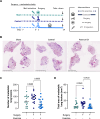Exercise boost after surgery improves survival in model of metastatic breast cancer
- PMID: 40066446
- PMCID: PMC11891249
- DOI: 10.3389/fimmu.2025.1533798
Exercise boost after surgery improves survival in model of metastatic breast cancer
Abstract
Introduction: Despite advances in breast cancer diagnosis and treatment of the primary tumor, metastatic breast cancer tumors remain largely incurable, and their growth is responsible for the majority of breast cancer-related deaths. There is therefore a critical need to identify ways to reduce metastatic tumor burden and increase breast cancer patient survival. While surgery and pharmacological treatments are the cornerstones of breast cancer intervention, epidemiological data suggests that physical activity can lower the risk of breast cancer development, improve adjuvant treatment tolerance, reduce the risk of disease recurrence and lower breast cancer-related death.
Methods: In this preclinical study, we set out to examine the impact of exercise on metastatic development in triple negative breast cancer (TNBC), using different 4T1 metastasis models, voluntary wheel running and surgical interventions. Tumors were analyzed for hypoxia and immune cell infiltration.
Results: Voluntary wheel running was observed to significantly increase metastasis-free survival, doubling the median survival time. However, these improvements were only observed when a boost in physical exercise occurred following surgery. To investigate this, we performed mock surgeries and confirmed surgical stress was needed to enable the positive effects of the boost in exercise on reducing metastatic tumor burden in mice with either spontaneous metastasis or experimentally-induced metastasis. These changes occurred in the absence of alterations in tumor growth, hypoxia and immune cell infiltration.
Discussion: Taken together, our results suggest that having a boost of physical activity following surgery may be beneficial to delay breast cancer metastatic development.
Keywords: breast cancer; metastasis; physical exercise; surgery; tumor microenvironment.
Copyright © 2025 Stagaard, Jensen, Schauer, Bay, Tavanez, Wielsøe, Peletier, Strøbech, Oria, Zornhagen, Albrechtsen, Christensen and Erler.
Conflict of interest statement
The authors declare that the research was conducted in the absence of any commercial or financial relationships that could be construed as a potential conflict of interest.
Figures




References
-
- PHESI Global Data Analysis Most Studied Disease Areas: January 2024 Gen Li, President and Founder, Phesi. Phesi.com. Available online at: https://21622507.fs1.hubspotusercontent-na1.net/hubfs/21622507/Phesi_GDA....
MeSH terms
LinkOut - more resources
Full Text Sources
Medical

